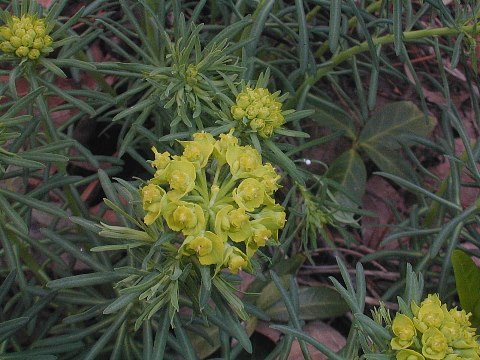Description: This herbaceous perennial plant is typically ½–1' tall (rarely up to 2' tall). It is unbranched in the lower half, but may form small side stems along the upper half of its central stem. These stems are light green, terete, and hairless. Toward the bottom of the central stem, there are small scale-like leaves; otherwise, the leaves are linear in shape (1/8" or 3 mm. across and up to 1½" long), hairless, and smooth along their margins. These leaves are arranged alternately from each other all around each stem and they are olive green to blue-green. However, the uppermost leaves underneath each inflorescence are arranged in a whorl of 10 or more. Both the leaves and stems exude a sticky white latex when they are damaged. Each stem terminates in an umbel or umbel-like cyme of 10-18 greenish yellow flowers. The pedicels of the flowers are pale green and hairless. The flowers are usually monoecious (separate male & female flowers on each plant).

The flowers are
arranged in pairs (the female flower is exerted on a short stalk above
the male flower). Each male flower consists of a cyathium (a cup-shaped
structure), which has 4 spreading glandular appendages along its rim.
These appendages are either kidney-shaped (reniform) or shaped like a
crescent moon (lunate). Inside the cyathium, are several stamens. Each
female flower consists of a globoid 3-lobed ovary (later, a seed
capsule) that has 3 styles at its apex. Both the male and female
flowers lack sepals and petals. Underneath each pair of male and female
flowers, there is a pair of yellowish green bracts that are
oval-cordate in shape. The flowers are only 1/8" (3 mm.) across, while
the
bracts are about ¼" (6 mm.) across. The blooming period usually occurs
from
late spring to mid-summer, but sometimes it extends into the fall. Each
seed capsule contains up to 3 seeds. Individual seeds are 2-3 mm. long
and ovoid-oblongoid in shape; they have smooth surfaces. The root
system is fibrous and strongly rhizomatous. Clonal colonies of
plants are often formed.
Cultivation:
Cypress Spurge is typically found in areas that have full sun to light
shade, more or less mesic conditions, and soil containing loam or sand.
It spreads aggressively and can be difficult to eliminate.
Range & Habitat:
The non-native Cypress Spurge naturalizes occasionally in central and
northern
Illinois, but it is less common in the southern section of the state.
Habitats include pioneer cemetery prairies, open woodlands, roadsides,
vacant lots, and pastures. This plant is still cultivated in gardens,
parks, and cemeteries, even though it is invasive. Cypress Spurge is
usually found in open disturbed areas, but it can invade high quality
prairies and other natural habitats with some degree of success.
Faunal Associations:
According to Müller (1873/1883), the flowers of Cypress Spurge attract
a wide variety of insects, including bees, wasps, flies, beetles, plant
bugs, and lepidoptera. These insects are attracted to the floral nectar
and/or pollen. Several flea beetles feed on Cypress Spurge: Aphthona
abdominalis, Aphthona cyparissiae, Aphthona
czwalinae, Aphthona flava, Aphthona
lacertosa, and Aphthona nigriscutis.
These flea beetles were originally introduced from Europe to control
infestations of Euphorbia esula (Leafy Spurge), but
they will feed on similar species in the Esula subgenus (of which
Cypress Spurge is a member). The aphids Aphis pulchella,
Macrosiphum euphorbiae, and Macrosiphum
gei suck juices from the foliage of Euphorbia spp.
(Spurges). The seeds of spurges are sometimes eaten by the Greater
Prairie Chicken, Bobwhite, Mourning Dove, Horned Lark, and Chipping
Sparrow. Because the white latex of the foliage is somewhat toxic,
mammalian herbivores rarely consume the foliage of Cypress Spurge.
Photographic Location:
A wooded area of Allerton Park in Piatt County, Illinois.
Comments:
Cypress Spurge has interesting foliage and rather weird-looking
flowers, but it has a tendency to escape from cultivation and may
become invasive of neighboring habitats. This species resembles Euphorbia
esula (Leafy Spurge), but it is smaller in size and its
leaves are more narrow (1/8" across or less). The needle-like leaves of
Cypress Spurge also distinguishes it from other Euphorbia spp.
(Spurges). Another common name of Euphorbia cyparissias
is Graveyard Weed.